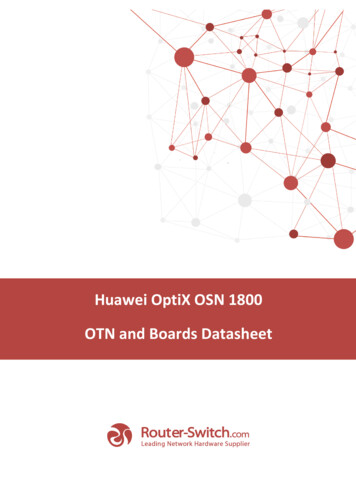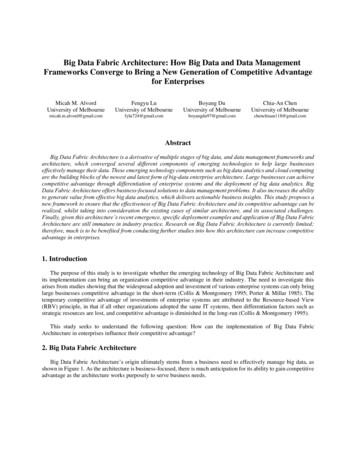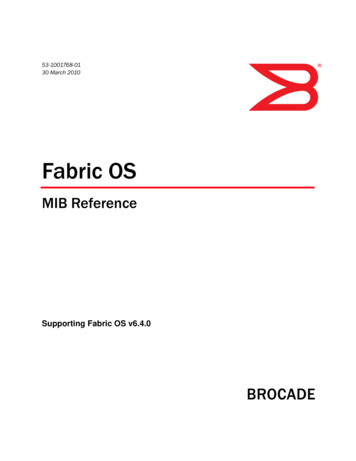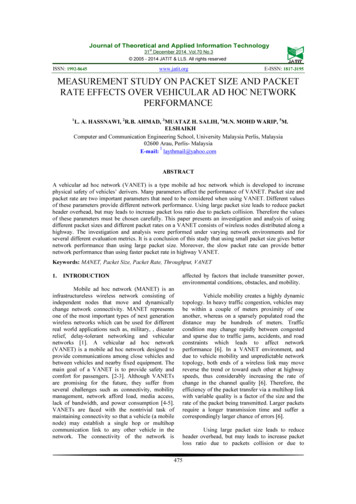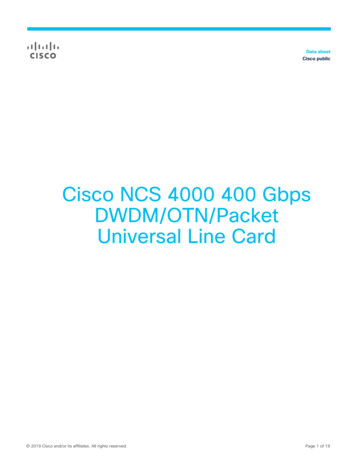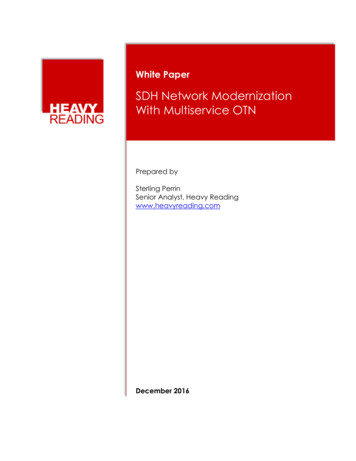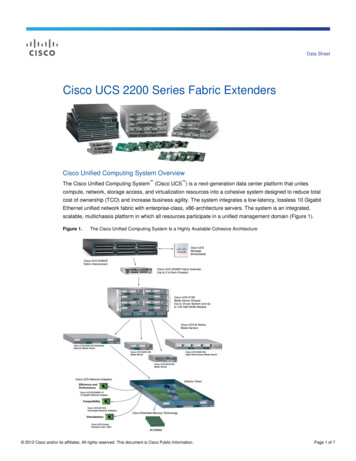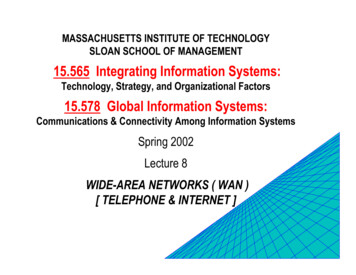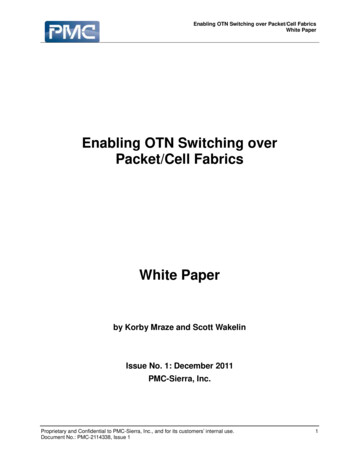
Transcription
Enabling OTN Switching over Packet/Cell FabricsWhite PaperEnabling OTN Switching overPacket/Cell FabricsWhite Paperby Korby Mraze and Scott WakelinIssue No. 1: December 2011PMC-Sierra, Inc.Proprietary and Confidential to PMC-Sierra, Inc., and for its customers’ internal use.Document No.: PMC-2114338, Issue 11
Enabling OTN Switching over Packet/Cell FabricsWhite PaperLegal InformationCopyrightCopyright 2011 PMC-Sierra, Inc. All rights reserved.The information in this document is proprietary and confidential to PMC-Sierra, Inc., and for itscustomers’ internal use. In any event, no part of this document may be reproduced orredistributed in any form without the express written consent of PMC-Sierra, Inc.PMC-2114338, Issue 1DisclaimerNone of the information contained in this document constitutes an express or implied warrantyby PMC-Sierra, Inc. as to the sufficiency, fitness or suitability for a particular purpose of anysuch information or the fitness, or suitability for a particular purpose, merchantability,performance, compatibility with other parts or systems, of any of the products of PMC-Sierra,Inc., or any portion thereof, referred to in this document. PMC-Sierra, Inc. expressly disclaimsall representations and warranties of any kind regarding the contents or use of the information,including, but not limited to, express and implied warranties of accuracy, completeness,merchantability, fitness for a particular use, or non-infringement.In no event will PMC-Sierra, Inc. be liable for any direct, indirect, special, incidental orconsequential damages, including, but not limited to, lost profits, lost business or lost dataresulting from any use of or reliance upon the information, whether or not PMC-Sierra, Inc. hasbeen advised of the possibility of such damage.TrademarksFor a complete list of PMC-Sierra’s trademarks and registered trademarks, visit:http://www.pmc-sierra.com/legal/Other product and company names mentioned herein may be the trademarks of their respectiveowners.PatentsThe technology discussed in this document is protected by one or more patent grants.Proprietary and Confidential to PMC-Sierra, Inc., and for its customers’ internal use.Document No.: PMC-2114338, Issue 12
Enabling OTN Switching over Packet/Cell FabricsWhite PaperAbstractOTN switching delivers a cost-effective, scalable, low-latency switching layer to address themassive bandwidth scaling required to deal with packet traffic growth. Furthermore, it deliversthis scale in such a way that it can transparently transport legacy services such as TDMconcurrent with the packet traffic. Service providers are demanding converged packet/OTNboxes, often referred to as Packet Optical Transport Platforms (P-OTPs), which support highcapacity OTN switching as well as packet functions such as Ethernet statistical multiplexingand MPLS-TP switching. TDM traffic is traditionally switched over a TDM-optimized switchfabric, and packet is traditionally switched over a packet/cell fabric. Maintaining two fabrics ischallenging in terms of cost, power, and operational complexity. This white paper discusses howOTN switching can be accomplished over a converged fabric which also natively supportspacket switching.About PMC-SierraPMC (Nasdaq:PMCS) is the semiconductor innovator transforming networks that connect,move and store digital content. Building on a track record of technology leadership, we aredriving innovation across storage, optical and mobile networks. Our highly integrated solutionsincrease performance and enable next generation services to accelerate the networktransformation. For more information, visit www.pmc-sierra.com.About the AuthorsKorby Mraze is a Manager in the Communications Products Division at PMC-Sierra and hasresponsibility for supporting customers with system-level implementation of OTN in nextgeneration optical equipment, including P-OTPs. Mr. Mraze has been with PMC-Sierra for over13 years and has supported virtually every product in PMC’s communications portfolio.Scott Wakelin is a Product Manager in the Communication Products Division at PMC-Sierraand has responsibility for OTN and optical transport solutions. Mr. Wakelin has over 12 yearsof experience delivering innovative semiconductor solutions that implement OTN,SONET/SDH, Ethernet, and PPP/Frame Relay to the networking industry. Mr. Wakelin holdsa Master of Applied Science degree that was focused on network infrastructure and security.Proprietary and Confidential to PMC-Sierra, Inc., and for its customers’ internal use.Document No.: PMC-2114338, Issue 13
Enabling OTN Switching over Packet/Cell FabricsWhite PaperRevision HistoryIssueNo.Issue DateDetails of Change1December2011Document CreatedProprietary and Confidential to PMC-Sierra, Inc., and for its customers’ internal use.Document No.: PMC-2114338, Issue 14
Enabling OTN Switching over Packet/Cell FabricsWhite PaperTable of ContentsLegal Information . 2Copyright . 2Disclaimer . 2Trademarks . 2Patents . 2Abstract . 3About PMC-Sierra . 3About the Authors . 3Revision History. 41 Introduction . 82 References . 93 Requirements for OTN Switching over a Packet/Cell Fabric . 103.1 Packet/Cell Fabrics . 103.2 Criteria for OTN Switching . 113.2.1 Scalability & Flexibility . 113.2.2 Packet Delay Variation Tolerance . 113.2.3 Tolerant to Packet Loss . 123.2.4 Protection Switching . 123.2.5 Timing Transparency . 123.2.6 Jitter Performance . 124 Enabling Technologies . 134.1 Constant Bit Rate Interface (CBRI) . 134.1.1 ODUk Packet Format . 144.1.2 Packet Delay Variation Compensation . 154.2 OPSA . 154.2.1 OPSA Building Blocks . 164.2.2 Jitter Performance of OPSA . 184.3 OTN Protection with CBRI and OPSA . 194.3.1 OTN Line Card and OTN Fabric Card Protection . 205 Conclusion . 22Proprietary and Confidential to PMC-Sierra, Inc., and for its customers’ internal use.Document No.: PMC-2114338, Issue 15
Enabling OTN Switching over Packet/Cell FabricsWhite PaperList of FiguresFigure 1 System Reference Model . 10Figure 2 Packet and Cell Fabric Requirements for OTN Switching . 11Figure 3 PMC-Sierra’s OTN Packet Header Format . 14Figure 4 OTN Packet with Packet Header in Interlaken Protocol . 15Figure 5 Retaining OTN Rate Information Through a Fabric . 16Figure 6 Packet Maker Block . 17Figure 7 Packet Maker Packets . 17Figure 8 Packet Monitor Block . 18Figure 9 Reassembled ODUk and Packet Sizes . 18Figure 10 Generic System APS Topology. 20Figure 11 OTN Line Card Protection . 20Figure 12 OTN Fabric Card Protection. 21Proprietary and Confidential to PMC-Sierra, Inc., and for its customers’ internal use.Document No.: PMC-2114338, Issue 16
Enabling OTN Switching over Packet/Cell FabricsWhite PaperList of TablesTable 1 CBRI ODUk Capacity . 13Table 2 Packet Header Usage . 14Table 3 G.8251 Jitter Generation Requirements . 19Table 4 G.8251 Jitter Transfer Requirements . 19Proprietary and Confidential to PMC-Sierra, Inc., and for its customers’ internal use.Document No.: PMC-2114338, Issue 17
Enabling OTN Switching over Packet/Cell FabricsWhite Paper1 IntroductionToday, carrier networks are anchored on SONET/SDH for both Layer 1 transport and switching,with G.709 Optical Transport Network (OTN) used primarily as a digital wrapper on long haulinterfaces. However, as discussed in [1], rapid packet traffic growth calls for a transportmechanism capable of transporting packets efficiently. Efficient transport of packet traffic overSONET/SDH infrastructure requires the use of VCAT/LCAS, which is operationally complexand expensive to deploy.OTN addresses the limitations of SONET/SDH by virtue of payload areas that are right-sizedfor GE, 10GE, 40GE or 100GE signals. OTN defines Optical channel Payload Units, OPUks,which are well suited for Gigabit Ethernet (k 0) to 100 Gigabit Ethernet (k 4), and via theOPUflex is adaptable to any packet traffic rate or to any other arbitrary client type, such as FibreChannel. OTN switching delivers two primary benefits to service providers. First, it allowsthem to efficiently groom client traffic into higher rate containers such as OTU1, OTU2, OTU3,or OTU4 so that wavelengths are used efficiently. Second, it provides a mechanism to separateclient and network optics, providing both capital cost and operational cost efficiency.A recent Infonetics survey [2] revealed both a clear demand for electrical switching of OTN(74% of respondents) and a clear need for switching down to the ODU0 level, with 79% ofrespondents saying they plan to deploy ODU0 level switching in the next 2 to 3 years.Therefore, the question is no longer if OTN switching at the electrical level is required, but howit will be deployed. As discussed in [1], there are two leading architectures:1. Packet Optical Transport Platforms (P-OTP): Combines OTN switching and packetswitching in a single platform.2. Optical Transport Platforms (OTP): Provides OTN switching only, with CarrierEthernet services provided by a separate Carrier Ethernet Switch/Router (CESR)platform.One area that has garnered particular interest from network equipment designers is the use ofpacket/cell fabrics for OTN switching. The availability of such fabrics, and the inherent packetswitching capability make this a particularly appealing option if a method can be devised toswitch OTN traffic within ITU performance specifications.To this end, PMC-Sierra has developed two fundamental technologies which enable OTN trafficand its timing to be transmitted over a packet/cell fabric:1. Constant Bit Rate Interface (CBRI): A standards based interface between an OTNprocessor and the fabric.2. OTN Phase Signaling Algorithm (OPSA): A method to convey OTN timing acrossthe fabric.Most recently, PMC-Sierra has led an industry-wide initiative in the Optical InterworkingForum (OIF) to standardize the manner in which an OTN processor interfaces to a packet/cellfabric for OTN switching. As a result of this industry wide effort, the OIF has recently ratifiedthe OTN over Packet Fabric Protocol Implementation Agreement which is based on PMCSierra’s CBRI and OPSA technologies.This white paper begins by examining the system level issues and requirements that must bemet in order to switch OTN traffic over a packet or cell fabric. Following this, the twofundamental enabling technologies, CBRI and OPSA, are explored in detail.Proprietary and Confidential to PMC-Sierra, Inc., and for its customers’ internal use.Document No.: PMC-2114338, Issue 18
Enabling OTN Switching over Packet/Cell FabricsWhite Paper2 References1. PMC-2110752, PMC-Sierra, Enabling OTN Convergence White Paper, Issue 12. OTN Deployment Strategies: Global Service Provider Survey. Infonetics Research.Retrieved 22 March 2011 http://www.infonetics.com.3. Interlaken Alliance, Interlaken Protocol Definition Version 1.2Proprietary and Confidential to PMC-Sierra, Inc., and for its customers’ internal use.Document No.: PMC-2114338, Issue 19
Enabling OTN Switching over Packet/Cell FabricsWhite Paper3 Requirements for OTN Switching over a Packet/CellFabricFirst and foremost, OTN switching in P-OTP and OTP platforms requires a centralized fabric inorder to switch OTN traffic from one line card to another. The system designer has severalfabric options, including:1.2.3.4.Packet or cell based fabricsTDM based OTN fabricsDigital Cross PointsSONET/SDH fabricsThough TDM-based OTN fabrics and crossbar fabrics present clear advantages over packetfabrics for OTN switching, such as extremely low latency, and SONET/SDH fabrics requirecomplex adaptation and concatenation schemes in order to support either OTN or packet, theOIF made an effort to enable interoperable OTN switching line cards using off-the-shelf fabrics.This effort resulted in the OIF ratifying a set of requirements based around packet fabrics.Packet fabrics were chosen for their (a) availability and (b) ability to converge both packet andTDM services.The remainder of this section explores a system reference model for OTN switching and therequirements that it imposes on a system.3.1 Packet/Cell FabricsFigure 1 shows the system reference model for OTN switching over a packet/cell fabric. In thismodel, the OTN processor extracts the ODUk signals from received OTUk signals, packetizesthem, and transfers them over the fabric via the FIC device. Similarly, client signals (Ethernet,SAN, Video and other CBR clients) are mapped into an ODUk by the OTN processor whichthen packetizes the ODUk, and transfers it to the fabric. In this manner, all of the intelligencefor adapting the OTN traffic for switching purposes is held within the OTN processor.Figure 1 System Reference ModelLine Card ine Card ‘B’OTN over PacketFabric ProtocolOpticsOpticsODUkOTNProcessorOTN over PacketFabric ticsOTU1OTU2OTU3OTU4FE/GE10GEFC/SANVideoODUk Flows using OTNover Packet FabricProtocolPacket/cell fabric architectures are centralized fabric topologies in which the fundamental unitof data transfer is a variable sized packet or fixed sized cell. The fabric typically operatesasynchronously to the traffic that is switched over it.Proprietary and Confidential to PMC-Sierra, Inc., and for its customers’ internal use.Document No.: PMC-2114338, Issue 110
Enabling OTN Switching over Packet/Cell FabricsWhite PaperAs one would expect, a packet/cell fabric is meant for switching packets including Ethernet andMPLS. As such, packet fabrics are not inherently suitable for switching OTN without extraconsideration. There are six basic requirements that must be met in order to switch OTN trafficover such a fabric. Figure 2 summarizes these requirements into two categories:1. Requirements imposed on the interface between the OTN processor and the fabric2. Requirements imposed on the timing characteristics of the systemFigure 2 Packet and Cell Fabric Requirements for OTN SwitchingInterfaceTimingScalability & FlexibiltyTransparencyTolerance to Packet LossTolerance to PDVSupport for Protection SwitchingJitter ComplianceSupport for Protection SwitchingLet’s explore these requirements in further detail.3.2 Criteria for OTN SwitchingThis section explores the requirements for a mechanism that enables OTN switching over apacket/cell fabric.3.2.1Scalability & FlexibilityThe interface between the OTN processor and the fabric must be scalable and flexible,including support for the following:4. Line cards that scale from NxSFP to Nx100G port densities;5. Hundreds of traffic flows per line card;6. Payload rates from ODU0 (1.25G) to ODU4 (100G) on the same card, with adaptabilityto future rates including ODU5 (not yet defined); and7. Arbitrary-size payloads, including any legal ODUflex rate.In ODUflex implementations, the mechanism must allow for ODUflex hitless resizing asdefined by ITU-T G.HAO.3.2.2Packet Delay Variation TolerancePacket/cell fabrics are subject to varying delays due to congestion, scheduling changes andother factors. This packet delay variation (PDV) must not affect performance when switchingOTN traffic through the packet/cell fabric. Appropriate buffering is required to emulate a fixeddelay when switching OTN traffic from the OTN processor on an ingress line card, through thepacket/cell fabric, to the OTN processor on the egress line card. Therefore, the interfacebetween the OTN processor and the fabric (or Fabric Interface Chip) must support flow control.Proprietary and Confidential to PMC-Sierra, Inc., and for its customers’ internal use.Document No.: PMC-2114338, Issue 111
Enabling OTN Switching over Packet/Cell FabricsWhite Paper3.2.3Tolerant to Packet LossIf a packet containing a portion of an ODUk frame were to be lost or dropped by the fabric, thelost data would result in a loss of frame event that could have network wide implications.As a result, the mechanism for OTN switching over a packet/cell fabric must not only detect theoccurrence of a lost packet, but take reparative measures such as replacing the lost data.Although the lost data will result in a burst of errors, the impact will be less severe than a loss offrame event.3.2.4Protection SwitchingProtected OTN traffic switched over a packet/cell fabric must recover from failure conditionswithin 50ms. The packet stream start up mechanism following a failure must be done in amanner that ensures the 50ms switchover time can be met.3.2.5Timing TransparencyIn SONET/SDH, the containers that transport the payload float within the overall framestructure. Pointer movements are used to adapt one timing domain to another. In SONET/SDHswitching systems, the SONET/SDH signal is effectively retimed to synchronize it to the localfabric.In contrast, OTN is an asynchronous protocol and has no such floating payload or system ofpointer movements for retiming. In order to avoid buffer overflows or underflows, the egressline card must transmit an ODUk at the same rate at which it was received at the ingress linecard. In order to accomplish this, the timing for an ODUk that is to be switched across a fabricmust be transmitted along with the ODUk.OTN is different from SONET/SDH in that the network need not be synchronous. Every ODUkcircuit has a unique phase within the transport network. This simplifies the network since not allnetwork elements need to be synchronized to one another. Furthermore, each ODUk circuit israte-adapted to its constituent payload due to the fact that the OTN frame is created by simplywrapping around the constituent packet or TDM client.The OTN frame structure is always a fractional multiple of the client being transported andtherefore cannot have its payload synchronized to the fabric, as is done in a more traditionalTDM-based SONET/SDH cross-connect. A new scheme is required to transport OTN over apacket/cell fabric transparently so that both its timing and its content are completely unaltered.3.2.6Jitter PerformanceOTN client signals traversing a packet/cell fabric must meet the ITU-T RecommendationG.8251 ODCr and ODCp timing specifications. This must be done for the maximum number ofnetwork elements allowed by the G.8251 Hypothetical Reference Model. Any scheme for thesegmentation of OTN traffic into packets and subsequent reassembly must adhere to the abovespecifications.Proprietary and Confidential to PMC-Sierra, Inc., and for its customers’ internal use.Document No.: PMC-2114338, Issue 112
Enabling OTN Switching over Packet/Cell FabricsWhite Paper4 Enabling TechnologiesTwo fundamental technologies are required to enable an ODUk and its timing to be transmittedover a packet/cell fabric:1. A standards-based interface between the OTN processor and the fabric.2. A method to convey ODUk timing across the fabric.A channelized scalable link-level protocol is needed from the OTN processor to the fabric thatnot only meets the requirements of the next generation of P-OTPs, but can scale to meet theirneeds in coming years. PMC-Sierra’s implementation of this interface is the Constant Bit RateInterface (CBRI) which is built on Interlaken. CBRI uses a packet header which is compliant tothe OIF’s OTN over Packet Fabric Protocol (OPFP).In order to convey the timing information of OTN traffic over a packet/cell fabric, a method isrequired to encode the traffic rate within OTN packets without adding any overhead. PMCSierra’s mechanism, the OTN Phase Signaling Algorithm (OPSA), is compliant to the OIF’sOPFP.This section introduces PMC-Sierra’s CBRI and OPSA technologies and highlights how theymeet the requirements in the previous section.4.1 Constant Bit Rate Interface (CBRI)As stated above, CBRI is based upon the Interlaken Protocol. The Interlaken ProtocolSpecification Version 1.2 is a multilane scalable packet interface that supports bandwidthtransfers from 10 Gbps to 120 Gbps. Furthermore, Interlaken is channelized, allowing for 10s or100s of ODUk’s to be supported per line card. Flow control is also supported.The Interlaken interface has standardized bandwidths that are composed of multiple SERDESlanes operating at a variety of rates. Table 1 shows the maximum number of ODUk streams thatcan be transferred over an interface of a given bandwidth. As an example, a 10 G InterlakenInterface can support 8 ODU0s, while a 50 G Interlaken interface can support 32 ODU0s.Combinations of various ODUk sizes are also supported so long as the overall bandwidth of theinterface is not exceeded.Table 1 CBRI ODUk U2StreamsODU3StreamsODU4Streams10 Gbps841N/AN/A25 Gbps1682N/AN/A50 Gbps321641N/A100 Gbps8040102N/A120 Gbps96481231Proprietary and Confidential to PMC-Sierra, Inc., and for its customers’ internal use.Document No.: PMC-2114338, Issue 113
Enabling OTN Switching over Packet/Cell FabricsWhite Paper4.1.1ODUk Packet FormatThe OTN over Packet Fabric Protocol defines a packet header that is prepended to each OTNpacket prior to being sent into the fabric. The mandatory section of the header provides bit fieldsused to perform such functions as packet delay variation compensation, dropped packetrecovery, packet sequence numbers and client status. These bit fields are shown in Figure 3.Figure 3 PMC-Sierra’s OTN Packet Header Format0.8 bytes4 bytesBnom 1 bytesUser OH and Fabric Overhead(Optional)OTN over Packet Fabric (OFP) HeaderODUk/ODUflex PayloadUser OH and Fabric Overhead(Optional)16 bits6 bits2 bits2 bits3 bits2 bitsTimestampRSV 1SQPPSI 1CSIPPSI 21PThe fields of the OIF OTN over Packet Fabric Protocol packet header are described in Table 2along with PMC’s usage of each field.Table 2 Packet Header UsageFieldOIF Defined UsagePMC-Sierra UsageTimestampUsed primarily to tune a packet delay variation(packet jitter) buffer on line cards in a packet/cellfabricSame as OIFRSV 1Optionally combined with the existing sequencebits to generate a larger sequence numberUsed by PMC devices to increasethe sequence number rangeSQUsed to detect packet drops due to bit errors orcongestionSame as OIFPPSI 1Indicates the size of the previous packet toensure the replacement packet of a dropped ispacket sized correctly to avoid a change in framealignment for the ODUk/ODUflex streamSame as OIFCSIOptionally used to indicate the status of the clientGenerates interrupts uponchanges in state, used to declaresignal fail indicationsPPSI 2Optionally indicates the size of the secondprevious packetNot supportedPA 1-bit odd parity calculation over the entireheaderSame as OIFUser Specificand Fabric OHOptional 0-12 byte field reserved for userproprietary data and fabric overheadUp to an 8 byte user defined fieldis supportedPayloadODUk/ODUflex packet of size Bnom-1, Bnom, orBnom 1 bytesSame as OIFFigure 4 shows the entire OTN packet including standard and optional header along with theOTN payload inside an Interlaken formatted packet. The Interlaken protocol wraps the BurstControl Word Start of Packet and End of Packet around the OTN related data.Proprietary and Confidential to PMC-Sierra, Inc., and for its customers’ internal use.Document No.: PMC-2114338, Issue 114
Enabling OTN Switching over Packet/Cell FabricsWhite PaperFigure 4 OTN Packet with Packet Header in Interlaken ProtocolCBRI PacketBCW(SOP)Packet MakerHeader1 bit 2 bits 1 bit 1 bitBurst Control Word(SOP)Inv10CtrlTypeODUk PayloadBCW(EOP)1 bit4 bits1 bit16 bits8 bits8 bits24 L USECRC 24Bit[66]Bit[0]64 bitsData Word #1Up to 8 Optional OH Bytesx01Bit[66]Bit[0]32 bits32 bitsData Word #2x01ODUk PayloadOFP HeaderBit[66]Bit[0]64 bitsx01Data Word #NODUk PayloadBit[66]x BytesLast DataWordx01Bit[0]y BytesODUk PayloadPaddingBit[66]Bit[0]1 bit 2 bits 1 bit 1 bitBurst Control Word(EOP)Inv10CtrlType1 bit4 bits1 bit16 bits8 bits8 bits24 L USECRC 24Bit[66]4.1.2Bit[0]Packet Delay Variation CompensationThe packet delay variation compensation function of the packet header is achieved bymonitoring the timestamp field. In order to use the timestamp field, all line cards in the nodemust share a common 8 kHz reference frame pulse and a common 311.04 MHz reference clock.The 8 kHz pulse is distributed to all line cards in the system to provide the ability to measurethe “age” of the packets that it is receiving. This packet age is used to determine how old thepacket is relative to the maximum age or maximum packet delay the fabric can have. The ageinformation is then used as part of a flow control mechanism to tune a PDV buffer to theappropriate depth to ensure each packet reaches the packet reassembly block with the samedelay.4.2 OPSAIn the OIF’s OTN over Packet Fabric Protocol (OPFP), the OTN rate information is encoded byvarying the size of the ODUk packets by 1 byte based upon a 311.04 MHz system referenceclock. The packets are generated on the ingress line card at a nominal size (B), nominal minusone byte (B-1) or nominal plus one byte (B 1) over a period of T system reference clock cycles.To determine the rate of the ODUk stream, the size of the OPFP packets can be measured andthen low pass filtered at the egress line card.Proprietary and Confidential to PMC-Sierra, Inc., and for its customers’ internal use.Document No.: PMC-2114338, Issue 115
Enabling OTN Switching over Packet/Cell FabricsWhite PaperBy encoding this rate information into the packet data itself, the packets are transferred over thepacket/cell fabric and then reassembled and transmitted out at the original clock rate when theOTN traffic leaves the fabric. PMC-Sierra’s OTN processors generate the B /-1 ODUk rateinformation in compliance with the OIFs OTN over Packet Protocol, ensuring interoperabilitywith 3rd party implementations. PMC-Sierra extends this functionality with the OPSA algorithmwhich provides enhanced jitter performance
White Paper Proprietary and Confidential to PMC-Sierra, Inc., and for its customers' internal use. 8 Document No.: PMC-2114338, Issue 1 1 Introduction Today, carrier networks are anchored on SONET/SDH for both Layer 1 transport and switching, with G.709 Optical Transport Network (OTN) used primarily as a digital wrapper on long haul interfaces.


